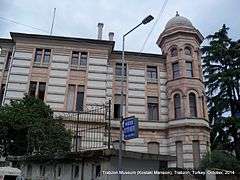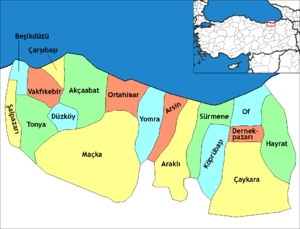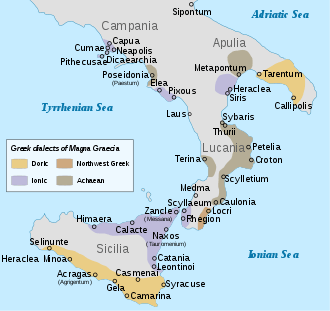Trabzon
Trabzon (Turkish pronunciation: [ˈtɾabzon]), historically known as Trebizond in English, is a city on the Black Sea coast of northeastern Turkey and the capital of Trabzon Province. Trabzon, located on the historical Silk Road, became a melting pot of religions, languages and culture for centuries and a trade gateway to Persia in the southeast and the Caucasus to the northeast.[3] The Venetian and Genoese merchants paid visits to Trebizond during the medieval period and sold silk, linen and woolen fabric. Both republics had merchant colonies within the city – Leonkastron and the former 'Venetian castle' – that played a role to Trebizond similar to the one Galata played to Constantinople (modern Istanbul).[4] Trabzon formed the basis of several states in its long history and was the capital city of the Empire of Trebizond between 1204 and 1461. During the early modern period, Trabzon, because of the importance of its port, again became a focal point of trade to Persia and the Caucasus.
Trabzon | |
|---|---|
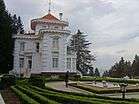 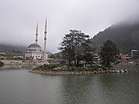 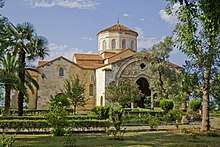  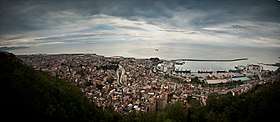 From top to bottom and left to right: Sumela Monastery viewed from across the Altındere valley; Atatürk's House; Lake Uzungöl; Hagia Sophia of Trabzon; Atatürk Square; a general view of the city centre from Boztepe. | |
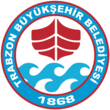 Emblem of Trabzon Metropolitan Municipality | |
| Nickname(s): City of Tale in the East | |
 Trabzon Location in Turkey 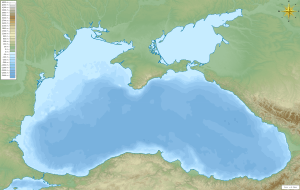 Trabzon Trabzon (Black Sea) | |
| Coordinates: 41°00′18″N 39°43′21″E | |
| Country | Turkey |
| Region | Black Sea Region |
| Province | Trabzon |
| Established | c. 756 BCE |
| Government | |
| • Governor | İsmail Ustaoğlu |
| • Mayor | Murat Zorluoğlu (AKP) |
| Area | |
| • District | 188.85 km2 (72.92 sq mi) |
| Elevation | 0 m (0 ft) |
| Population (2012)[2] | |
| • Urban | 312,060 |
| • Urban density | 1,700/km2 (4,300/sq mi) |
| • Metro | 779,379 |
| Demonym(s) | Trapezian, Trapezuntine, Trebizonian, Trabzonlu |
| Time zone | UTC+3 (FET) |
| Postal code | 61xxx |
| Area code(s) | (+90) 462 |
| Licence plate | 61 |
| Climate | Cfa |
Name
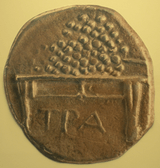
The Turkish name of the city is Trabzon. It is historically known in English as Trebizond. The first recorded name of the city is the Greek Tραπεζούς (Trapezous), referencing the table-like central hill between the Zağnos (İskeleboz) and Kuzgun streams on which it was founded (τράπεζα meant "table" in Ancient Greek; note the table on the coin in the figure.) In Latin, Trabzon was called Trapezus, which is a latinization of its ancient Greek name. Both in Pontic Greek and Modern Greek, it is called Τραπεζούντα (Trapezounta). In Ottoman Turkish and Persian, it is written as طربزون. During Ottoman times, Tara Bozan was also used.[5][6][7][8] Some western geographers used this name instead of the Latin Trebizond. In Laz it is known as ტამტრა (T'amt'ra) or T'rap'uzani,[9] in Georgian it is ტრაპიზონი (T'rap'izoni) and in Armenian it is Տրապիզոն Trapizon. The 19th-century Armenian travelling priest Byjiskian called the city by other, native names, including Hurşidabat and Ozinis.[10] Other versions of the name, which have incidentally been used in English literature as well, include: Trebizonde (Fr.), Trapezunt (German), Trebisonda (Sp.), Trapesunta (It.), Trapisonda, Tribisonde, Terabesoun, Trabesun, Trabuzan, Trabizond and Tarabossan.
In Spanish the name was known from chivalric romances and Don Quixote. Because of its similarity to trápala and trapaza,[11] trapisonda acquired the meaning "hullabaloo, imbroglio"[12]
History
Iron Age and Classical Antiquity
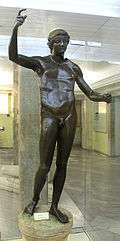
.jpg)
Before the city was founded as a Greek colony the area was dominated by Colchian (Caucasian) and Chaldian (Anatolian) tribes. It is possible that the settlement origins of Trabzon go back to these tribes. The Hayasa, who had been in conflict with the Central-Anatolian Hittites in the 14th century BCE, are believed to have lived in the area south of Trabzon. Later Greek authors mentioned the Macrones and the Chalybes as native peoples. One of the dominant Caucasian groups to the east were the Laz, who were part of the monarchy of the Colchis, together with other related Georgian peoples.[13][14][15]
According to Greek sources, the city was founded in classical antiquity in 756 BCE as Tραπεζούς (Trapezous), by Milesian traders from Sinope. It was one of a number (about ten) of Milesian emporia or trading colonies along the shores of the Black Sea. Others included Abydos and Cyzicus in the Dardanelles, and nearby Kerasous. Like most Greek colonies, the city was a small enclave of Greek life, and not an empire unto its own, in the later European sense of the word. As a colony Trapezous initially paid tribute to Sinope, but early banking (money-changing) activity is suggested occurring in the city already in the 4th century BCE, according to a silver drachma coin from Trapezus in the British Museum, London. Cyrus the Great added the city to the Achaemenid Empire, and was possibly the first ruler to consolidate the eastern Black Sea region into a single political entity (a satrapy).
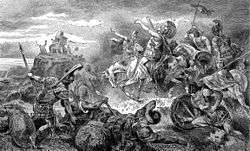
Trebizond was the first Greek city the Ten Thousand reached on their retreat from Persia. 19th c. illustration by Herman Vogel.
Trebizond's trade partners included the Mossynoeci. When Xenophon and the Ten Thousand mercenaries were fighting their way out of Persia, the first Greek city they reached was Trebizond (Xenophon, Anabasis, 5.5.10). The city and the local Mossynoeci had become estranged from the Mossynoecian capital, to the point of civil war. Xenophon's force resolved this in the rebels' favor, and so in Trebizond's interest.
Up until the conquests of Alexander the Great the city remained under the dominion of the Achaemenids. While the Pontus was not directly affected by the war, its cities gained independence as a result of it. Local ruling families continued to claim partial Persian heritage, and Persian culture had some lasting influence on the city; the holy springs of mt. Minthrion to the east of the old town were devoted to the Persian-Anatolian Greek god Mithra. In the 2nd century BCE the city with its natural harbours was added to the Kingdom of Pontus by Pharnaces I. Mithridates VI Eupator made it the home port of the Pontic fleet, in his quest to remove the Romans from Anatolia.
After the defeat of Mithridates in 66 BCE the city was first handed to the Galatians, but it was soon returned to the grandson of Mithradates, and subsequently became part of the new client Kingdom of Pontus. When the kingdom was finally annexed to the Roman province of Galatia two centuries later, the fleet passed to new commanders, becoming the Classis Pontica. The city received the status of civitas libera, extending it judicial autonomy and the right to mint its own coin. Trabzon gained importance for its access to roads leading over the Zigana Pass to the Armenian frontier or the upper Euphrates valley. New roads were constructed from Persia and Mesopotamia under the rule of Vespasian. In the next century, the emperor Hadrian commissioned improvements to give the city a more structured harbor.[16] The emperor visited the city in the year 129 as part of his inspection of the eastern border (limes). A mithraeum now serves as a crypt for the church and monastery of Panagia Theoskepastos (Kızlar Manastırı) in nearby Kizlara, east of the citadel and south of the modern harbor.
.jpg)
Trebizond was greatly affected by two events over the following centuries: in the civil war between Septimius Severus and Pescennius Niger, the city suffered for its support of the latter, and in 257 the city was pillaged by the Goths, despite reportedly being defended by "10,000 above its usual garrison", and being defended by two bands of walls.[16]
Although Trebizond was rebuilt after being pillaged by the Goths in 257 and the Persians in 258, the city did not soon recover. Only in the reign of Diocletian appears an inscription alluding to the restoration of the city; Ammianus Marcellinus could only write of Trebizond that it was "not an obscure town." Christianity had reached Trebizond by the third century, for during the reign of Diocletian occurred the martyrdom of Eugenius and his associates Candidius, Valerian, and Aquila.[17] Eugenius had destroyed the statue of Mithras which overlooked the city from Mount Minthrion (Boztepe), and became the patron saint of the city after his death. Early Christians sought refuge in the Pontic Mountains south of the city, where they established Vazelon Monastery in 270 AD and Sumela Monastery in 386 AD. As early as the First Council of Nicea, Trebizond had its own bishop.[18] Subsequently, the Bishop of Trebizond was subordinated to the Metropolitan Bishop of Poti.[18] Then during the 9th century, Trebizond itself became the seat of the Metropolitan Bishop of Lazica.[18]
Byzantine period
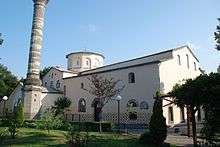
By the time of Justinian, the city served as an important base in his Persian Wars, and Miller notes that a portrait of the general Belisarius "long adorned the church of St. Basil."[19] An inscription above the eastern gate of the city, commemorated the reconstruction of the civic walls following an earthquake at Justinian's expense.[19] At some point before the 7th century the university (Pandidakterion) of the city was reestablished with a quadrivium curriculum. The university drew students not just from the Byzantine Empire, but from Armenia as well.[20]
The city regained importance when it became the seat of the theme of Chaldia. Trebizond also benefited when the trade route regained importance in the 8th to 10th centuries; 10th-century Muslim authors note that Trebizond was frequented by Muslim merchants, as the main source transshipping Byzantine silks into eastern Muslim countries.[21] According to the 10th century Arab geographer Abul Feda it was regarded as being largely a Lazian port. The Italian maritime republics such as the Republic of Venice and in particular the Republic of Genoa were active in the Black Sea trade for centuries, using Trabzon as an important seaport for trading goods between Europe and Asia.[4] Some of the Silk Road caravans carrying goods from Asia stopped at the port of Trebizond, where the European merchants purchased these goods and carried them to the port cities of Europe with ships. This trade provided a source of revenue to the state in the form of custom duties, or kommerkiaroi, levied on the goods sold in Trebizond.[22] The Greeks protected the coastal and inland trade routes with a vast network of garrison forts.[23]
Following the Byzantine defeat at the Battle of Manzikert in 1071, Trebizond came under Seljuk rule. This rule proved transient when an expert soldier and local aristocrat, Theodore Gabras took control of the city from the Turkish invaders, and regarded Trebizond, in the words of Anna Comnena, "as a prize which had fallen to his own lot" and ruled it as his own kingdom.[24] Supporting Comnena's assertion, Simon Bendall has identified a group of rare coins he believes were minted by Gabras and his successors.[25] Although he was killed by the Turks in 1098, other members of his family continued his de facto independent rule into the next century.
Empire of Trebizond
The Empire of Trebizond was formed after Georgian expedition in Chaldia,[26] commanded by Alexios Komnenos a few weeks before the sack of Constantinople. Located at the far northeastern corner of Anatolia, it was the longest surviving of the Byzantine successor states. Byzantine authors, such as Pachymeres, and to some extent Trapezundines such as Lazaropoulos and Bessarion, regarded the Trebizond Empire as being no more than a Lazian border state. Thus from the point of view of the Byzantine writers connected with the Lascaris and later with the Palaiologos, the rulers of Trebizond were not emperors.[27][28]

(now Ayasofya mosque & museum)
(now Yeni Cuma Mosque)
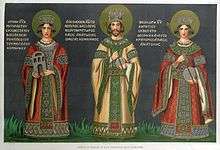
Geographically, the Empire of Trebizond consisted of little more than a narrow strip along the southern coast of the Black Sea, and not much further inland than the Pontic Mountains. However, the city gained great wealth from the taxes it levied on the goods traded between Persia and Europe via the Black Sea. The Mongol siege of Baghdad in 1258 diverted more trade caravans towards the city. Genoese and to a lesser extent Venetian traders regularly came to Trabzon. To secure their part of the Black Sea trade, the Genoese bought the coastal fortification "Leonkastron", just west of the winter harbour, in the year 1306. One of the most famous persons to have visited the city in this period was Marco Polo, who ended his overland return journey at the port of Trebizond, and sailed to his hometown Venice with a ship; passing by Constantinople (Istanbul) on the way, which was retaken by the Byzantines in 1261.
Together with Persian goods, Italian traders brought stories about the city to Western Europe. Trebizond played a mythical role in European literature of the late middle-ages and the Renaissance. Miguel de Cervantes and François Rabelais gave their protagonists the desire to possess the city.[29] Next to literature, the legendary history of the city – and that of the Pontus in general – also influenced the creation of paintings, theatre plays and operas in Western Europe throughout the following centuries.
The city also played a role in the early Renaissance; The western takeover of Constantinople, which formalized Trebizond's political independence, also led Byzantine intellectuals to seek refuge in the city. Especially Alexios II of Trebizond and his grandson Alexios III were patrons of the arts and sciences. After the great city fire of 1310, the ruined university was reestablished. As part of the university Gregory Choniades opened a new academy of astronomy, which housed the best observatory outside Persia. Choniades brought with him the works of Shams al-Din al-Bukhari,[30] Nasir al-Din al-Tusi and Abd al-Rahman al-Khazini from Tabriz, which he translated into Greek. These works later found their way to western Europe, together with the astrolabe. The observatory Choniades built would become known for its accurate solar eclipse predictions, but was probably used mostly for astrological purposes for the emperor and/or the church.[31] Scientists and philosophers of Trebizond were among the first western thinkers to compare contemporaneous theories with classical Greek texts. Basilios Bessarion and George of Trebizond travelled to Italy and taught and published works on Plato and Aristotle, starting a fierce debate and literary tradition that continues to this day on the topic of national identity and global citizenship. They were so influential that Bessarion was considered for the position of Pope, and George could survive as an academic even after being defamed for his heavy criticism of Plato.
The Black Death arrived at the city in September 1347, probably via Kaffa. At that time the local aristocracy was engaged in the Trapezuntine Civil War. Constantinople remained the Byzantine capital until it was conquered by the Ottoman Sultan Mehmed II in 1453, who also conquered Trebizond eight years later, in 1461.
Its demographic legacy endured for several centuries after the Ottoman conquest in 1461, as a substantial number of Greek Orthodox inhabitants, usually referred to as Pontic Greeks, continued to live in the area during Ottoman rule, up until 1923, when they were deported to Greece. A few thousand Greek Muslims still live in the area, mostly in the Çaykara-Of dialectical region to the southeast of Trabzon. Most are Sunni Muslim, while there are some recent converts in the city and possibly a few Crypto-Christians in the Tonya/Gümüşhane area to the southwest of the city. Compared to most previously Greek cities in Turkey, a large amount of its Greek Byzantine architectural heritage survives as well.
Ottoman era
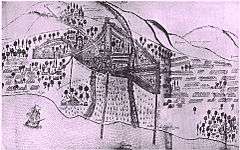
.jpg)
The last Emperor of Trebizond, David, surrendered the city to Sultan Mehmed II of the Ottoman Empire in 1461.[32] Following this takeover, Mehmed II sent many Turkish settlers into the area, but the old ethnic Greek, Laz and Armenian communities remained. According to the Ottoman tax books (tahrir defterleri), the total population of adult males in the city was 1,473 in the year 1523.[33] Approximately 85% of them (1,252 adult males) were Christian, 13% of whom (197 adult males) were Armenian, and 15% of them (221 adult males) were Muslim.[33] However, a large portion of the local Christians were Islamized and Turkified by the end of the 17th century, according to a research by Prof. Halil İnalcık on the tax books (tahrir defterleri) of the Ottoman Empire. Trabzon was sanjak centre in Rum Eyalet (1461–1514) and (1520–1535), Erzincan-Bayburt eyalet (1514–1517), Anadolu Eyalet (1517–1520) and Erzurum Eyalet (1535–1598).[34]
It was the capital of the Ottoman Eyalet of Trebizond (1598–1867) and later of the Ottoman Vilayet of Trebizond (1867–1923) in the northeastern part of Anatolia. During the reign of Sultan Bayezid II, his son Prince Selim (later Sultan Selim I) was the sancakbeyi of Trabzon, and Selim I's son Suleiman the Magnificent was born in Trabzon on November 6, 1494. The Ottoman government often appointed local Chepni and Laz beys as the regional beylerbey. It is also recorded that some Bosniak beys were also appointed by the Sublime Porte as the regional beylerbeys in Trabzon. The Beylerbeylik of Trabzon (Trabzon Beylerbeyliği) had always sent troops for the Ottoman campaigns in Europe during the 16th and 17th centuries.
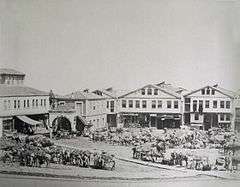
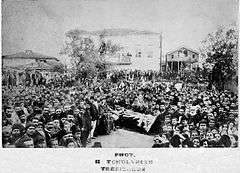
Trebizond had a wealthy merchant class during the late Ottoman period, and the local Christian minority had a substantial influence in terms of culture, economy and politics. A number of European consulates were opened in the city due to its importance in regional trade and commerce. In the first half of the 19th century, Trebizond even became the main port for Persian exports. However, the opening of the Suez Canal greatly diminished the international trading position of the city. In the last decades of the 19th century, the city saw some demographic changes. Many residents from the wider region (mostly Christians, but also some Jews and Greek or Turkish speaking Muslims) started to migrate to the Crimea and southern Ukraine, in search for farmland or employment in one of the booming cities along the northern and eastern coasts of the Black Sea. Among these migrants were the grandparents of Bob Dylan and Greek politicians and artists. At the same time, thousands of Muslim refugees from the Caucasus arrived in the city, especially after 1864, in what is known as the Circassian genocide.
Next to Constantinople, Smyrna (now Izmir) and Salonika (now Thessaloniki), Trebizond was one of the cities where western cultural and technological innovations were first introduced to the Ottoman Empire. In 1835, the American Board of Commissioners for Foreign Missions opened the Trebizond Mission station that it occupied from 1835 to 1859 and from 1882 to at least 1892.[35] Hundreds of schools were constructed during the first half of the 19th century, giving the region one of the highest literacy rates of the empire. The city got a post office in 1845. New churches and mosques were built in the second half of the 19th century, as well as the first theater, public and private printing houses, multiple photo-studios and banks. The oldest known photographs of the city center date from the 1860s and depict one of the last camel trains from Persia.
Between one and two thousand Armenians are believed to have been killed in the Trebizond vilayet during the Hamidian massacres of 1895. While this number was low in comparison to other Ottoman provinces, its impact on the Armenian community in the city was large. Many prominent Armenian residents, among them scholars, musicians, photographers and painters, decided to migrate towards the Russian Empire or France. The large Greek population of the city was not affected by the massacre.[36] Ivan Aivazovsky made the painting Massacre of the Armenians in Trebizond 1895 based on the events.[37] Due to the high number of Western Europeans in the city, news from the region was being reported on in many European newspapers. These western newspapers were in turn also very popular among the residents of the city.
Ottoman era paintings and drawings of Trebizond
 Trebizond from the sea by Ivan Aivazovsky
Trebizond from the sea by Ivan Aivazovsky Engraving of the port at Çömlekçi by C. Lapante
Engraving of the port at Çömlekçi by C. Lapante Trebizond by Jean-Baptiste Henri Durand-Brager
Trebizond by Jean-Baptiste Henri Durand-Brager Trebizond from the sea by Y.M. Tadevossian
Trebizond from the sea by Y.M. Tadevossian.jpg) Trebizond from the south by Godfrey Vigne
Trebizond from the south by Godfrey Vigne The quarentine station by Jules Laurens
The quarentine station by Jules Laurens Street view by Nikolay Lanceray
Street view by Nikolay Lanceray
Modern era
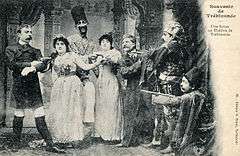
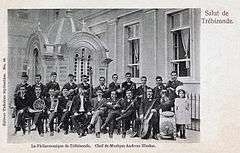
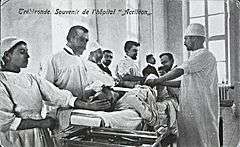
In 1901 the harbour was equipped with cranes by Stothert & Pitt of Bath in England. In 1912 the Sümer Opera House was opened on the central Meydan square, being one of the first in the empire. The city lost many young male citizens at the Battle of Sarikamish in the winter of 1914–15. The coastal region between the city and the Russian frontier was the site of key battles between the Ottoman and Russian armies during the Trebizond Campaign, part of the Caucasus Campaign of World War I. A bombardment of the city in 1915 by the Russian navy cost the lives of 1300 citizens.[38]
In July 1915, most of the adult male Armenians of the city were marched off south in five convoys, towards the mines of Gümüşhane, never to be seen again. Other victims of the Armenian Genocide were reportedly taken out to sea in boats which were then capsized.[39][40]
The Russian army landed at Atina, east of Rize on March 4, 1916. Lazistan Sanjak fell within two days. However, due to heavy guerrilla resistance around Of and Çaykara some 50 km to the east of Trabzon, it took a further 40 days for the Russian army to advance west.[41] The Ottoman administration of Trabzon foresaw the fall of the city and called for a meeting with community leaders, where they handed control of the city to Greek metropolitan bishop Chrysantos Philippidis. Chrysantos promised to protect the Muslim population of the city. Ottoman forces retreated from Trabzon, and on April 15 the city was taken without a fight by the Russian Caucasus Army under command of Grand Duke Nicholas and Nikolai Yudenich. Many adult Turkish males left the city out of fear for reprisals, even though governor Chrysantos included them in his administration. According to some sources the Russians banned Muslim mosques, and forced Turks, who were the largest ethnic group living in the city, to leave Trabzon.[42] However, already during the Russian occupation many Turks who had fled to surrounding villages started to return to the city, and governor Chrysantos helped them to re-establish their facilities such as schools, to the dismay of the Russians. During the Russian Revolution of 1917 Russian soldiers in the city turned to rioting, with officers commandeering Trebizonian ships to flee the scene. The Russian Army ultimately retreated from the city and the rest of eastern and northeastern Anatolia. In December 1918 Trabzon deputy Hafız Mehmet gave a speech at the Ottoman parliament in which he blamed the former governor of Trebizond Vilayet Cemal Azmi – who had fled to Germany after the Russian invasion – for orchestrating the Armenian Genocide in the city in 1915, by means of drowning. Subsequently, a series of war crimes trials were held in Trebizond in early 1919 (see Trebizond during the Armenian Genocide). Among others, Cemal Azmi was sentenced to death in absentia.
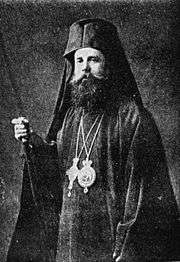
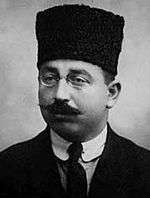
During the Turkish War of Independence several Christian Pontic Greek communities in the Trebizond vilayet rebelled against the new army of Mustafa Kemal (notably in Bafra and Santa), but when nationalist Greeks came to Trabzon to proclaim revolution, they were not received with open arms by the local Pontic Greek population of the city. At the same time the Muslim population of the city, remembering their protection under Greek governor Crhysantos, protested the arrest of prominent Christians. Liberal delegates of Trebizond opposed the election of Mustafa Kemal as the leader of the Turkish revolution at the Erzurum Congress. The governor and mayor of Trebizond were appalled by the violence against Ottoman Greek subjects,[43] and the government of Trabzon thus refused arms to Mustafa Kemal's henchman Topal Osman, who was responsible for mass murders in the western Pontus. Osman was forced out of the city by armed Turkish port-workers.[44] Following the war and the annulment of the Treaty of Sèvres (1920), which was replaced by the Treaty of Lausanne (1923), Trebizond became part of the new Turkish republic. The efforts of the pro-Ottoman, anti-nationalist population of Trebizond only postponed the inevitable, because the national governments of Turkey and Greece agreed to a mutual forced population exchange. This exchange included well over one hundred thousand Greeks from Trebizond and the vicinity, to the relatively new Greek state.[45] During the war Trebizond parliamentarian Ali Şükrü Bey was one of the leading figures of the first Turkish opposition party. Through his newspaper Tan, Şükrü and his colleagues publicized their critiques of the Kemalist government, such as its violence towards Greeks during the population exchange.

Topal Osman's men would eventually murder parliamentarian Şükrü for his criticism of the nationalist government of Mustafa Kemal. Topal Osman was later sentenced to death and killed while resisting arrest. After pressure from the opposition his headless body was hanged by his foot in front of the Turkish parliament. Ali Şükrü Bey, who had studied in Deniz Harp Okulu (Turkish Naval Academy) and worked as a journalist in the United Kingdom, is seen as a hero by the people of Trabzon, while in neighboring Giresun there is a statue of his murderer Topal Osman.
During World War II shipping activity was limited because the Black Sea had again become a war zone. Hence, the most important export products, tobacco and hazelnuts, could not be sold and living standards degraded.
As a result of the general development of the country, Trabzon has developed its economic and commercial life. The coastal highway and a new harbour have increased commercial relations with central Anatolia, which has led to some growth. However, progress has been slow in comparison to the western and the southwestern parts of Turkey.
Trabzon is famous throughout Turkey for its anchovies called hamsi, which are the main meal in many restaurants in the city. Major exports from Trabzon include hazelnuts and tea.
The city still has a sizable community of Greek-speaking Muslims, most of whom are originally from the vicinities of Tonya, Sürmene and Çaykara. However, the variety of the Pontic Greek language - known as "Romeika" in the local vernacular, Pontiaka in Greek, and Rumca in Turkish - is spoken mostly by the older generations.[46]
Population
| Population | 2007 | 2008 | 2009 | 2010 | 2011 | 2012 | 2013 | 2014 | 2015 |
|---|---|---|---|---|---|---|---|---|---|
| Total | 740,569 | 748,982 | 765,127 | 763,714 | 757,353 | 757,898 | 758,237 | 766,782 | 768,417 |
| Urban | 396,646 | 390,797 | 408,103 | 415,652 | 757,353 | 757,898 | 758,237 | 766,782 | 768,417 |
| Source: TurkStat (Turkish Statistical Institute)[47] | |||||||||
Geography and climate
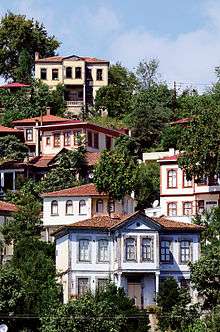
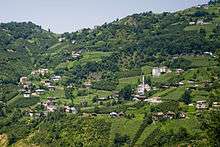
Trabzon Province has a total area of 4,685 square kilometres (1,809 sq mi) and is bordered by the provinces of Rize, Giresun and Gümüşhane. The total area is 22.4% plateau and 77.6% hills. The Pontic Mountains pass through the Trabzon Province.
Trabzon used to be an important reference point for navigators in the Black Sea during harsh weather conditions. The popular expression "perdere la Trebisonda" (losing Trebizond) is still commonly used in the Italian language to describe situations in which the sense of direction is lost.[4] The Italian maritime republics such as Venice and in particular Genoa were active in the Black Sea trade for centuries.[4]
Trabzon has four lakes: Uzungöl, Çakırgöl, Sera and Haldizen Lakes. There are several streams, but no rivers in Trabzon.
Climate
Trabzon has a climate typical of the Black Sea region with plentiful precipitation. Under the Köppen climate classification, it has a humid subtropical climate (Köppen: Cfa)[48] Summers are warm and humid, and the average maximum temperature is around 26.7 °C (80 °F) in August. Winters are cool and damp, and the lowest average minimum temperature is around 5 °C (41 °F) in January. Trabzon's summers are warmer than oceanic classifications, but the narrow fluctuations in temperature render a significant influence from the sea. As with other major cities on the Black Sea coast of Turkey, Trabzon is situated right on the waterfront, thus allowing for the additional 1–2 °C (1.8–3.6 °F) enough to surpass the threshold to be classified as subtropical. In comparison, only 1 or 2 percent of the province is classified as subtropical, the majority being oceanic (Köppen: Cfb) followed by humid continental climate (Köppen: Dfb), due to the immediate elevation increase starting from the coast, a typical characteristic of the Black Sea coast of Turkey. The Pontic Alps get a significant amount of snow during winters. The temperatures may drop as low as -30 °C (-22 °F). In some places the snow can stay on the ground during summer months. Trabzon's weather station also sees tendencies of a Mediterranean climate (Köppen: Csa), but with only one month below 40 mm (1.6 in) rainfall in summer it just fails to qualify.
Precipitation is heaviest in autumn and winter, with a marked reduction in the summer months, a microclimatic condition of the city center compared to the rest of the region. Snowfall is quite common between the months of December and March, snowing for a week or two, and it can be heavy once it snows.
The water temperature, like in the rest of the Black Sea coast of Turkey, is always cool and fluctuates between 8 °C (46 °F) and 20 °C (68 °F) throughout the year.
| Climate data for Trabzon (1929–2017) | |||||||||||||
|---|---|---|---|---|---|---|---|---|---|---|---|---|---|
| Month | Jan | Feb | Mar | Apr | May | Jun | Jul | Aug | Sep | Oct | Nov | Dec | Year |
| Record high °C (°F) | 25.9 (78.6) |
30.1 (86.2) |
35.2 (95.4) |
37.6 (99.7) |
38.2 (100.8) |
36.7 (98.1) |
37.0 (98.6) |
38.2 (100.8) |
36.7 (98.1) |
33.8 (92.8) |
32.8 (91.0) |
26.4 (79.5) |
38.2 (100.8) |
| Average high °C (°F) | 10.7 (51.3) |
10.7 (51.3) |
11.8 (53.2) |
15.5 (59.9) |
19.1 (66.4) |
23.1 (73.6) |
25.8 (78.4) |
26.5 (79.7) |
23.6 (74.5) |
20.0 (68.0) |
16.4 (61.5) |
12.9 (55.2) |
18.0 (64.4) |
| Daily mean °C (°F) | 7.3 (45.1) |
7.2 (45.0) |
8.3 (46.9) |
11.7 (53.1) |
15.9 (60.6) |
20.3 (68.5) |
23.1 (73.6) |
23.4 (74.1) |
20.3 (68.5) |
16.6 (61.9) |
12.8 (55.0) |
9.5 (49.1) |
14.7 (58.5) |
| Average low °C (°F) | 4.5 (40.1) |
4.3 (39.7) |
5.3 (41.5) |
8.6 (47.5) |
12.8 (55.0) |
16.9 (62.4) |
19.8 (67.6) |
20.3 (68.5) |
17.3 (63.1) |
13.6 (56.5) |
9.9 (49.8) |
6.6 (43.9) |
11.7 (53.1) |
| Record low °C (°F) | −7.0 (19.4) |
−7.4 (18.7) |
−5.8 (21.6) |
−2.0 (28.4) |
4.2 (39.6) |
9.2 (48.6) |
11.0 (51.8) |
13.5 (56.3) |
7.3 (45.1) |
3.4 (38.1) |
−1.6 (29.1) |
−3.3 (26.1) |
−7.4 (18.7) |
| Average precipitation mm (inches) | 82.0 (3.23) |
63.8 (2.51) |
58.1 (2.29) |
57.2 (2.25) |
51.6 (2.03) |
50.4 (1.98) |
35.5 (1.40) |
45.1 (1.78) |
78.5 (3.09) |
115.0 (4.53) |
99.1 (3.90) |
83.3 (3.28) |
819.6 (32.27) |
| Average precipitation days | 11.5 | 11.8 | 12.6 | 12.4 | 12.1 | 10.3 | 7.5 | 8.3 | 10.6 | 11.9 | 11.4 | 12.1 | 132.5 |
| Average relative humidity (%) | 69 | 69 | 73 | 75 | 77 | 75 | 73 | 73 | 74 | 73 | 70 | 68 | 72 |
| Mean monthly sunshine hours | 83.7 | 90.4 | 105.4 | 126.0 | 170.5 | 210.0 | 182.9 | 173.6 | 147.0 | 139.5 | 108.0 | 83.7 | 1,620.7 |
| Mean daily sunshine hours | 2.7 | 3.2 | 3.4 | 4.2 | 5.5 | 7.0 | 5.9 | 5.6 | 4.9 | 4.5 | 3.6 | 2.7 | 4.4 |
| Source 1: Turkish State Meteorological Service[49] | |||||||||||||
| Source 2: Weatherbase[50] | |||||||||||||
Economy
As of 1920, the port at Trabzon was considered "the most important of the Turkish Black Sea ports" by the British. It traded as far as Tabriz and Mosul. As of 1911, the Central Bank of the Republic of Turkey signed an agreement to develop a harbor at the port. When the Russians occupied Trabzon, a mole was built.[51] They built a breakwater and were responsible for creating an extended pier, making loading and unloading easier. In 1920, Trabzon produced linen cloth, silver filagree, tanning and small amounts of cotton, silk and wool. Tobacco and hazelnuts were exported.[52] The tobacco produced in Trabzon was called Trebizond-Platana. It was described as having "large leaves and a bright colour."[53] Trabzon was known for producing poor quality cereals, most which were grown for local use.[54]
Trabzon produced a white green bean, which was sold in Europe. It was, as of 1920, the only vegetable exported out of the province.[53] Poultry farming was also popular in Trabzon. Sericulture was seen in the area before 1914.[55] The area produced copper, silver, zinc, iron and manganese. Copper was kept for local use by coppersmiths. During the Balkan Wars production ceased due to poor exportation and fuel supplies.[56]
Trabzon Airport opened in 1957.
People
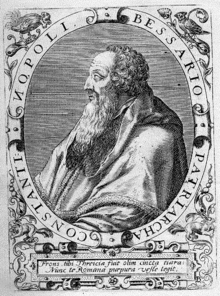
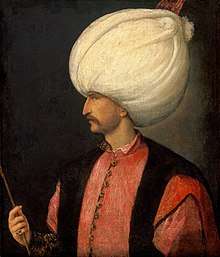
The current ethnic background of the people of Trabzon is mostly Turkish.[57][58] There are also descendants of Circassian muhajiris[59] in the city, as well as smaller number of Laz people, Muslim Greeks (Romeyka-speakers) and Armenians (Hemshin).[57][60] Local Turks are mostly of Chepni Turkmen origin.[61] The main language of these ethnic groups is Turkish.[62] Modern migration since the dissolution of the Soviet Union has brought a significant number of Russians, Ukrainians and people from the Caucasus (mostly Georgia) into the city. Russian language shops and facilities can be found in the town.
Pontic Greek has been spoken in the region since early antiquity. The local dialect developed along its own lines and is today partly intelligible to speakers of Standard Greek. It was spoken mainly by a Greek Orthodox multi-ethnic population up to the population exchange; nearly all speakers of this local variant of Pontic Greek are now Muslims. A very similar dialect is spoken by a community of about 400 speakers, descendants of Christians from the Of valley now living in Greece in the village of Nea Trapezounta (New Trebizond), today part of Katerini, Central Macedonia.[63]
Laz people, who are aboriginal to this area, also live in Trabzon. Numerous villages inside and out of Trabzon of the Laz date back as early as the period of Queen Tamar's rule (Georgian: თამარი, also transliterated as T'amar or Thamar; c. 1160 – 18 January 1213) in the newly unified Kingdom of Georgia. During the Queen's rule, sizeable groups of immigrating Georgians moved to Trabzon where they continue to preserve their native tongue. There was an Armenian community in Trebizond as early as the 7th century.[64]
During the 13th and 14th centuries, numerous Armenian families migrated there from Ani.[64] Robert W. Edwards published part of an early 15th-century diary from the Castilian ambassador who visited Trabzon and compared the churches of the Greek and Armenian communities.[65] It was stated by the ambassador that the Armenians, who were not well-liked by the Greeks, had a population large enough to support a resident bishop. According to Ronald C. Jennings, in the early 16th century, Armenians made up approximately 13 percent[66] of the city's population.[67] At present, Trabzon does not have an Armenian-speaking community.
The Chepni people, a tribe of Oghuz Turks who played an important role in the history of the eastern Black Sea area in the 13th and 14th centuries, live in the Şalpazarı (Ağasar valley) region of the Trabzon Province.[68] Very little has been written on the Turkification of the area. There are no historical records of any considerable Turkish-speaking groups in the Trabzon area until the late 15th century, with the exception of the Chepnis. The original Greek (and in some regions Armenian) speakers imposed features from their mother language into the Turkish spoken in the region. Heath W. Lowry's[69] work with Halil İnalcık on Ottoman tax books (Tahrir Defteri)[70] provides detailed demographic statistics for the city of Trabzon and its surrounding areas during the Ottoman period.
It is possible that the majority of the population of Trabzon and Rize (and other ancient Greek colonies in the Pontus region) — except up to the time of the Chepni Turk immigration waves — consisted of indigenous Caucasian tribes (the Colchians and the Laz) who had been partly Hellenized religiously and linguistically.[71] Michael Meeker stresses the cultural resemblances (e.g. in village structure, house types, and pastoral techniques) between the Eastern Black Sea coast and the areas in the Caucasus proper.[72]
Main sights
.jpg)
Trabzon has a number of tourist attractions, some of them dating back to the times of the ancient empires that once existed in the region. In the city itself, one can find a hub of shops, stalls and restaurants surrounding the Meydan, a square in the center of the city, which includes a tea garden.
- The Hagia Sophia (Turkish: Ayasofya Müzesi), a stunning Byzantine church, is probably the town's most important tourist attraction.
- Trabzon Castle ruins are visible in the town but cannot be visited as they fall in a military zone. The outside wall of the castle now serves as the back wall of a military building.
- The "Atatürk Köşkü" is a villa built in 1890 by a local Greek merchant. In 1924 Mustafa Kemal Atatürk stayed in the villa during his visit to Trabzon. He stayed there again in 1937. It houses period rooms and serves as a monument to the memory of the founder and first President of the Republic of Turkey.
- Boztepe Park is a small park and tea garden on the hills above Trabzon that has a panoramic view of nearly the entire city. The terrain in Trabzon is ascending in such a way that although the view is far above that of the buildings below, it is still close enough to be able to observe the flow of traffic and the people moving about in the city.
- Uzun Sokak is one of the most crowded streets of Trabzon.
- Trabzon Museum is located in the town centre and offers interesting exhibits on the history of the region, including an impressive collection of Byzantine artifacts.
- Trabzon's Bazaar District offers interesting shopping opportunities on ancient narrow streets, continuing from Kunduracılar Street from the Meydan (town square).
- Kostaki Mansion is located to the north of Zeytinlik near Uzun Sokak.
Other sites of the city include: Fatih Mosque (originally the Panagia Khrysokephalos Church), Yeni Cuma Mosque (originally the Agios Eugenios Church), Nakip Mosque (originally the Agios Andreas Church), Hüsnü Köktuğ Mosque (originally the Agios Elevtherios Church), İskender Pasha Mosque, Semerciler Mosque, Çarşı Mosque, Gülbahar Hatun Mosque and Türbe (commissioned by Sultan Selim I), Kalepark (originally Leonkastron).
Within Trabzon Province, the main attractions are the Sümela Monastery (i. e. the Monastery of the Panagia Soumelá) and the Uzungöl lake. The monastery is built on the side of a very steep mountain overlooking the green forests below and is about 50 kilometres (31 miles) south of the city. Uzungöl is known for its natural environment and scenery. Other sites of interest in the broader region include:
- Kaymaklı Monastery, a formerly Armenian Monastery of the All-Saviour (arm. Ամենափրկիչ Վանք, Amenaprgič Vank),
- Kızlar Monastery of Panagia Theoskepastos (the God-veiled Virgin),
- Kuştul Monastery of Gregorios Peristereotas (gr. Ιερά Μονή του Αγίου Γεωργίου Περιστερεώτα, Ierá Moní tou Agíou Georgíou Peristereóta),
- Vazelon Monastery of Agios Savvas (Maşatlık),
- Cave churches of Agia Anna (Little Ayvasıl), Sotha (St. John), Agios Theodoros, Agios Konstantinos, Agios Christophoros, Agia Kyriakí, Agios Michail and Panagia Tzita churches.[73]
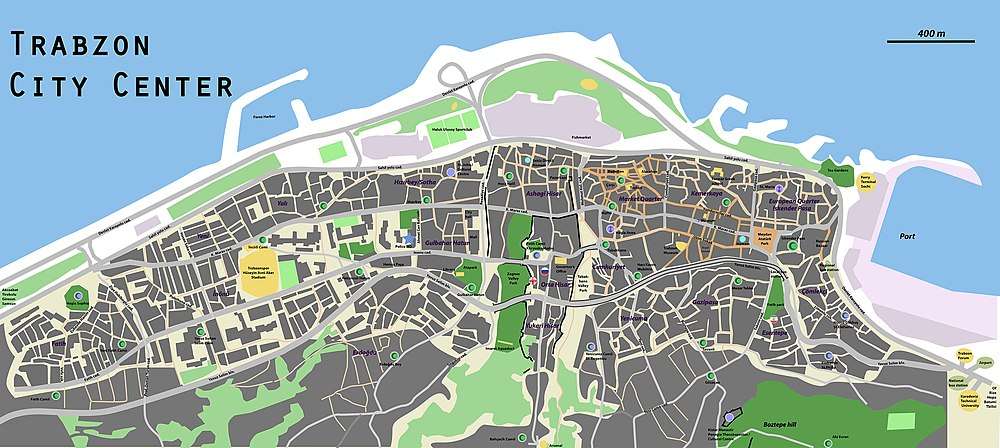
Culture
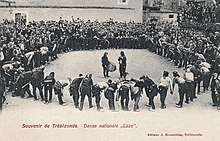
Folk dancing is still very much in evidence in the Black Sea region. The "Horon" is a famous dance that is indigenous to the city and its surrounding area. It is performed by men, women, the young and elderly alike; in festivities, local weddings and harvest times.[74] While similar to Russian Cossack dances in terms of vividness, the Trabzon folk dance is probably indigenous to the eastern Black Sea region, which has an impressive variety of folk music.
The people of Trabzon have a reputation for being religiously conservative and nationalist. Many Trabzonites generally show a strong sense of loyalty to their family, friends, religion and country. Atatürk selected his presidential guards from Trabzon and the neighbouring city of Giresun because of their fierce fighting ability and their loyalty.
Outside of the relatively urban space of Trabzon proper, and within parts of it as well, rural traditions from the Black Sea village life are still thriving. These include traditional gender roles, social conservatism, hospitality and a willingness to help strangers; and all aspects, both positive and negative, of an agrarian lifestyle, such as hard work, poverty, strong family ties, and a closeness to nature.
The people of the eastern Black Sea region are also known for their wit and sense of humour; many jokes in Turkey are told about the natives of the Black Sea region Karadeniz fıkraları (Black Sea jokes). The character Temel, a universal buffoon figure found in many cultures, forms an important part of the Turkish oral tradition.
The city's profile was raised somewhat in the English-speaking world by Dame Rose Macaulay's last novel, The Towers of Trebizond (1956), which is still in print.[75]
Education
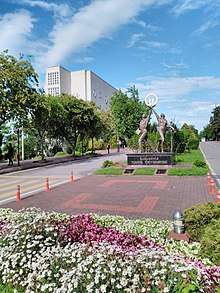
Black Sea Technical University in Trabzon hosts students from all over Turkey, especially from the Black Sea and East Anatolian regions, as well as students from the Turkic states in Central Asia.
Historically the city was a center of Greek culture and education and from 1683 to 1921, a teachers' college operated known as Phrontisterion of Trapezous, which provided a major impetus for the rapid expansion of Greek education throughout the region.[76] The building of this institution (built in 1902) still remains the most impressive Pontic Greek monument in the city and today hosts the Turkish school Anadolu Lisesi.[77]
Cuisine
Trabzon's regional cuisine is traditionally reliant on fish, especially hamsi (fresh European Anchovy similar to the British Sprat or American Smelt). Trabzon meets 20% of the total fish production in Turkey. Regional dishes include the Akçaabat köfte (spicy lamb meatball from the Akçaabat district), Karadeniz pidesi (canoe shaped pita bread, often filled with ground beef, cheese and eggs), kuymak (a Turkish fondue made with cornmeal, fresh butter and cheese), Vakfıkebir ekmeği (large country-style bread), Tonya tereyağı (Tonya butter), tava mısır ekmeği (deep-dish corn bread) and kara lahana çorbası (bean and cabbage soup). Taflan kavurması is a cherry laurel dish served with onions and olive oil. Trabzon is also famous for its hazelnuts. The Black Sea region of Turkey is the world's largest producer of cherry and hazelnut; and a large production area of tea; all of which play an important role in the local cuisine.
Sports
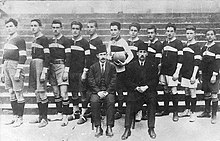
Football is the most popular sport in Trabzon. The city's top sports club, Trabzonspor, was until 2010 the only Turkish football club outside İstanbul to win the Süper Lig (six times), which was previously (until Trabzonspor's first championship title in the 1975–76 season) won only by the "Big Three" clubs of Istanbul, namely Galatasaray, Fenerbahçe and Beşiktaş. Due to Trabzonspor's success, the decades-old term "Big Three" which defined the most successful football clubs in Turkey had to be modified into the "Big Four". Trabzonspor is also one of the most successful Turkish clubs in the European Cups, managing to beat numerous prominent teams such as Barcelona, Inter, Liverpool, Aston Villa and Olympique Lyonnais. Renowned former players of Trabzonspor include Şenol Güneş, Lars Olsen and Shota Arveladze.
Trabzon hosted the First Edition of the Black Sea Games in July 2007 and the 2011 European Youth Summer Olympic Festival.
Notable residents
International relations
Twin towns - sister cities
Trabzon is twinned with:[78]
See also
- Amasya (ancient Amaseia, capital of the Pontic Greeks during classical antiquity)
- Anatolian Tigers
- Black Sea Region
- Kemençe of the Black Sea
- Kolbastı
- World Trade Center Trabzon
Notes and references
- "Area of regions (including lakes), km²". Regional Statistics Database. Turkish Statistical Institute. 2002. Retrieved 2013-03-05.
- "Population of province/district centers and towns/villages by districts - 2012". Address Based Population Registration System (ABPRS) Database. Turkish Statistical Institute. Retrieved 2013-02-27.
- Trabzon (tr) Archived 2011-11-03 at the Wayback Machine
- William Miller (2009). The Latin Orient. Bibliobazaar LLC. pp. 51–54. ISBN 978-1-110-86390-7.
- Campbell, Lawrence Dundas, The Asiatic annual register, or, A View of the history of Hindustan, and of the Politics, Commerce, Literature of Asia, London 1802 Page 3, Google books link
- Malte-Brun, Conrad, Universal geography: or a description of all parts of the world ..., Volume 2 Google Books
- "The modern traveller, a popular description geographical, historical, and topographical of the varieus countries of the globe". J. Dunkan. 14 January 2018. Retrieved 14 January 2018 – via Google Books.
- Ritter, Carl (14 January 2018). "Die Erdkunde im Verhältniss zur Natur und zur Geschichte des Menschen: oder Allgemeine, vergleichende Geographie, als sichere Grundlage des Studiums und Unterrichts in physikalischen und historischen Wissenschaften". G. Reimer. Retrieved 14 January 2018 – via Google Books.
- Y.Dutxuri. "Türkçe Lazca sözlük / Çeviri / Online Çeviri / Lazuri.Com". www.Lazuri.com. Retrieved 14 January 2018.
- Özhan Öztürk claims that Ozinis means "flat place" in Laz language and Hurşidabat means "City of the Sun" in Persian/Ottoman language. Pontus: Antik Çağ’dan Günümüze Karadeniz’in Etnik ve Siyasi Tarihi Genesis Yayınları. Ankara, 2011. pp. 547–549 ISBN 978-605-54-1017-9
- Corominas, Joan; Pascual, José A. (1991). Diccionario crítico etimológico castellano e hispánico (in Spanish). RI–X (3rd reprint ed.). Madrid: Gredos. p. 592. ISBN 84-249-0879-1.
- trapisonda en Diccionario de la Real Academia Española (in Spanish) (23rd ed.). 2019. Retrieved 24 July 2020.
- Phoenix: The Peoples of the Hills: Ancient Ararat and Caucasus by Charles Burney, David Marshall Lang, Phoenix Press; New Ed edition (December 31, 2001)
- Ronald Grigor Suny, The Making of the Georgian Nation: 2nd edition (December 1994), Indiana University Press, ISBN 0-253-20915-3, page 45
- "A Star in the East". TimothyGrove.Blogspot.ro. Retrieved 14 January 2018.
- William Miller, Trebizond: The Last Greek Empire, 1926, (Chicago: Argonaut Publishers, 1968), p. 9
- Miller, Trebizond, p. 10
- Hewsen, 46
- Miller, Trebizond, p. 11
- Calzolari, V. "The Armenian translation of the Greek Neoplatonic Works" in Greek Texts and Armenian Traditions: An Interdisciplinary Approach, 2016, p. 51
- R.B. Serjeant, Islamic Textiles: material for a history up to the Mongol conquest, 1972, pp 63, 213, noted by David Jacoby, "Silk Economics and Cross-Cultural Artistic Interaction: Byzantium, the Muslim World, and the Christian West", Dumbarton Oaks Papers 58 (2004:197–240) p. 219 note 112.
- Speros Vryonis, The Decline of Medieval Hellenism in Asia Minor and the Process of Islamization from the Eleventh through the Fifteenth Century (Berkeley: University of California, 1971), p. 16
- Robert W. Edwards, “The Garrison Forts of the Pontos: A Case for the Diffusion of the Armenian Paradigm,” Revue des Études Arméniennes 19, 1985, pp.181–284.
- Miller, Trebizond, p. 12
- Bendall, "The Mint of Trebizond under Alexius I and the Gabrades", Numismatic Chronicle, Seventh Series, 17 (1977), pp. 126–136
- A. A. Vasiliev, "The Foundation of the Empire of Trebizond (1204–1222)", Speculum, 11 (1936), pp. 18f
- Finlay, George. The History Of Greece From Its Conquest By The Crusaders To Its Conquest By The Turks And Of The Empire Of Trebizond, 1204–1461, By George Finlay. 1st ed. Edinburgh: W. Blackwood and sons, 1851. Print.
- Vasilev, A. A. The Foundation Of The Empire Of Trebizond 1204–1222. 1st ed. Cambridge, Mass.: Medieval Academy of America, 1936. Print.
- 'The lure of Trebizond' by Anthony Eastmond, in Byzantium's Other Empire: Trebizond, p. 22, 2016, Istanbul
- "Shams al‐Dīn al‐Bukhārī". Thomas Hockey et al. (eds.). The Biographical Encyclopedia of Astronomers. New York: Springer, 2007, pp. 1047–1048. Retrieved 12 January 2018.
- Astronomy in the Trebizond Empire Ahmet M. Zehiroğlu (trans. by Paula Darwish). from Trabzon İmparatorluğu 2016, Trabzon.
- Prothero, G.W. (1920). Anatolia. London: H.M. Stationery Office.
- The Armenian People from Ancient to Modern Times, Richard G. Hovannisian, page 27/28, 2004
- "Haber Yazdır : Trabzon'un fethi araştırmaları ve 15 ağustos 1461 – Of hayrat haberleri". www.OfHayrat.com. Retrieved 14 January 2018.
- Rev. M. P. Parmalee (1892). Proceedings of the ABCFM for the year 1892. Boston: Samuel Usher. p. 229. Retrieved 1 May 2017.
Trebizond was occupied as a missionary station in 1835... The following is a list of missionaries who have been connected with the station for at least one year: ... Rev. G. W. Wood, 1842 – 1843"
- Rev. Edwin Munsell Blis on the Hamidian Massacres in 'Modern Genocide: The Definitive Resource and Document Collection', 2014, p. 147, Paul R. Bartrop & Steven Leonard Jacobs (eds)
- Davidian, Vazken Khatchig. "Image of an Atrocity: Ivan (Hovhannes) Aivazovsky's Massacre of the Armenians in Trebizond 1895". Études Arméniennes Contemporaines. pp. 40–73. doi:10.4000/eac.1815.
- Daniel Maldonado in 'Historic Cities of the Islamic World', 2007, p. 525, C. Edmund Bosworth (ed)
- Toronto Globe, August 26, 1915.
- Takvimi Vekdyi, No. 3616, August 6, 1919, p. 2.
- Infographic by the newspaper The Sphere showing the advance of the Russian front on Trebizond, The Sphere, April 29, 1916
- Grand Larousse encyclopedia Turkish edition, 22, page: 11669, Librairie Larousse
- Seattle City Council and Asia Minor – The articles of Herbert Adams Gibbons in the Christian Science Monitor Stavros T. Stavridis in The National Herald, September 26, 2017
- Clark, Bruce (2006). Twice a Stranger: The Mass Expulsions that Forged Modern Greece and Turkey. Harvard University Press. pp. 112–116. ISBN 9780674023680. Retrieved 15 January 2018 – via Google Books.
- Baum, Wilhelm (2006). The Christian minorities in Turkey. Kitab. p. 162. ISBN 978-3-902005-62-5. "On October 11, 1922, Turkey concluded an armistice with the allied forces, but not with the Greeks. The Greeks in the other settlement areas of Asia Minor were also expelled at that time, like e.g. the Kappadocian Greeks in the Goreme area and the other Greeks in Pontus, in the Trebizond area and on the west coast."
- Özhan Öztürk: Pontus: Antik Çağ’dan Günümüze Karadeniz’in Etnik ve Siyasi Tarihi, Genesis Yayınları, Ankara, 2011, pp. 417–421, ISBN 978-605-54-1017-9; Peter Mackridge: Greek-Speaking Muslims of North-East Turkey: Prolegomena to a study of the Ophitic sub-dialect of Pontic, Byzantine and Modern Greek Studies, Oxford University Press, 1987, pp. 115–137; Ömer Asan: Pontus Kültürü, Belge Yayınları, Istanbul, 1996.
- "..::Welcome to Turkish Statistical Institute(TurkStat)'s Web Pages::." www.TurkStat.gov.tr. Retrieved 14 January 2018.
- Peel, M. C.; Finlayson, B. L.; McMahon, T. A. (2007). "Updated world map of the Köppen-Geiger climate classification" (PDF). Hydrology and Earth System Sciences. 4 (2): 439–473. doi:10.5194/hessd-4-439-2007.
- "Resmi İstatistikler: İllerimize Ait Genel İstatistik Verileri" (in Turkish). Turkish State Meteorological Service. Archived from the original on 22 January 2019. Retrieved 22 January 2019.
- "Trabzon, Turkey Travel Weather Averages (Weatherbase)". Weatherbase. Retrieved 14 January 2018.
- Prothero, W.G. (1920). Armenia and Kurdistan. London: H.M. Stationery Office. p. 51.
- Prothero, W.G. (1920). Armenia and Kurdistan. London: H.M. Stationery Office. p. 52.
- Prothero, W.G. (1920). Armenia and Kurdistan. London: H.M. Stationery Office. p. 61.
- Prothero, W.G. (1920). Armenia and Kurdistan. London: H.M. Stationery Office. p. 60.
- Prothero, W.G. (1920). Armenia and Kurdistan. London: H.M. Stationery Office. p. 64.
- Prothero, W.G. (1920). Armenia and Kurdistan. London: H.M. Stationery Office. p. 73.
- Gözler, Kemal. "Türkiye Cumhuriyeti Anayasası (1982)". www.Anayasa.gen.tr. Retrieved 14 January 2018.
- Türkiye Cumhuriyeti Anayasası, Madde 66
- "C-OSMANLI DEVLETİ'NİN GÖÇMENLERİ". webcache.GoogleUserContent.com. Retrieved 14 January 2018.
- Türkiye Cumhuriyeti Anayasası, Madde 66
- Sümer, Faruk, Çepniler
- Çelik, Ali, Doç.Dr., Çepnilerin Anadolu'nun Türkleştirilmesindeki Yeri Ve Önemi
- "www.latsis-foundation.org" (PDF). Archived from the original (PDF) on 2012-01-31. Retrieved 2011-10-29.
- Victor Amazaspovich Ambartsumian; Abel Poghosi Simonyan; Makich Vahani Arzumanyan (1986). Haykakan sovetakan hanragitaran ("Soviet Armenian Encyclopedia") (in Armenian). 12. Yerevan. p. 87. OCLC 10431241. Missing or empty
|title=(help)CS1 maint: uses authors parameter (link) - Robert W. Edwards, “Armenian and Byzantine Religious Practices in Early Fifteenth-Century Trabzon: A Spanish Viewpoint,” Revue des Études Arméniennes 23, 1992, pp. 81–90.
- 15.5% of 85%
- Jennings, Ronald C. (Jan. 1976) Urban Population in Anatolia in the 16th Century: International Journal of MiddleEast Studies, Vol. 7, No. 1 pp. 21–57.
- Bernt Brendemoen, The Turkish dialects of Trabzon, University of Oslo, 2002 p. 18
- Professor. Department of Near Eastern Studies. Princeton University
- Trabzon Şehrinin İslamlaşması ve Türkleşmesi 1461–1583 ISBN 975-518-116-4
- Michael Meeker, "The Black Sea Turks: some aspects of their ethnic and cultural background", International Journal of Middle East Studies (1971) 2:318–345
- Meeker, 1971: p. 326 "As the mentioned, the villages along the Black Sea coast from Ordu to Artvin are composed of many hamlets, each dominating a hilltop or mountainside on which its own crops are separately planted. This type of settlement pattern is in sharp contrast with the typical nucleated Anatolian village, but its characteristic of many rural settlements of the Western Caucasus notably those of Abkhaz, Circassians, Georgians, Mingrelians and Ossetes..."
For similar ideas See: Karl Koch, Reise duch Russland nach dem Kaukasis chen Istmus in den Jahren, 1836. vol1. p. 378; W.E.D. Allen, A History of the Georgian People, London 1932. pp. 54–5; Özhan Öztürk, Karadeniz. 2005. p. 35, 757–68. For linguistic influence see: Bernt Brendomoen, Laz influence on the Black Sea Turkish Dialects, 1990 (Proceedings from 32nd meeting of the Permanent International Altaistic Conference) - Karalahana.com Archived 2008-06-11 at the Wayback Machine
- People and culture of Trabzon and Black sea region Archived 2010-02-10 at the Wayback Machine
- Macaulay, Rose: The Towers of Trebizond (Collins, London, 1956)
- Özdalga, Elisabeth (2005). Late Ottoman society: the intellectual legacy. Routledge. p. 261. ISBN 978-0-415-34164-6.
- Bryer, Anthony; Winfield, David (2006). The post-Byzantine monuments of Pontos. Ashgate. p. xxxiii. ISBN 978-0-86078-864-5.
- "Kardeş Şehirler". trabzon.bel.tr (in Turkish). Trabzon. Retrieved 2020-01-17.
- Princeton Encyclopedia of Classical Sites eds. Richard Stillwell, William L. MacDonald, Marian Holland McAllister: "Trapezus"
- Özhan Öztürk (2005). Karadeniz (Black Sea): Ansiklopedik Sözlük. 2 Cilt. Heyamola Yayıncılık. Istanbul. ISBN 975-6121-00-9
- Bryer, Anthony; David Winfield (March 1985). Byzantine Monuments and Topography of the Pontos (Dumbarton Oaks Studies,20) Two Volume Set. Dumbarton Oaks Pub Service. ISBN 0-88402-122-X.
Further reading
- Nystazopoulou, Marie (1964). "La dernière reconquête de Sinope par les Grecs de Trébizonde (1254–1265)". Revue des études byzantines (in French). 22 (22): 241–249. doi:10.3406/rebyz.1964.1329.
- Schliefer, Yigal (2007-01-26). "Turkish city grapples with violent record". Christian Science Monitor.
- Arsu, Sebnem (2007-02-08). "Suspects in Journalist's Killing Came From a Hotbed of Turkish Ultranationalist Sentiment". New York Times.
External links
| Wikimedia Commons has media related to Trabzon. |
| Wikivoyage has a travel guide for Trabzon. |
_-_WGA17878.jpg)


